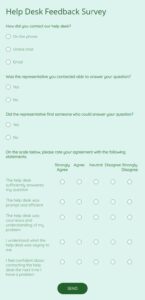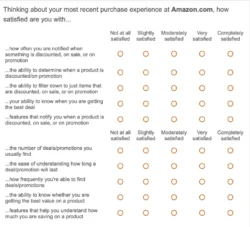Ever wonder if your support team is truly hitting the mark? In today’s fast-paced world, customer service isn’t just about solving problems; it’s about building relationships and fostering loyalty. Knowing how your customers feel about their interactions with your help desk is absolutely crucial for continuous improvement and achieving service excellence.
That’s where a well-crafted help desk satisfaction survey template comes in. It’s not just a collection of questions; it’s a strategic tool designed to gather actionable insights, pinpoint areas for improvement, and celebrate successes within your support operations. Let’s dive into why getting this right can transform your customer service.
Why Gathering Feedback is a Game-Changer
Ever felt like you’re guessing what your customers really think about your support? When it comes to help desk operations, simply closing tickets isn’t enough. To truly excel, you need to understand the customer experience from their perspective. Gathering feedback through a structured survey isn’t just a nice-to-have; it’s a critical component for any organization aiming for service excellence and long-term customer relationships.
The insights you gain from a comprehensive survey act as a roadmap for improvement. They help you pinpoint specific pain points, identify common issues, and understand where your team is excelling. This data-driven approach allows you to move beyond assumptions, ensuring that your training initiatives, process improvements, and resource allocations are all precisely targeted where they’re most needed. Think of it as a direct line to your customers’ thoughts, giving you the power to fine-tune your service delivery.
Furthermore, actively seeking feedback demonstrates to your customers that you value their opinion. This simple act can significantly boost customer loyalty and trust. When customers feel heard and see their feedback leading to positive changes, they are more likely to remain satisfied and even advocate for your brand. It transforms a transactional interaction into a relationship-building opportunity, fostering a positive perception of your entire support system.
Key Metrics Your Survey Can Uncover
A well-designed survey isn’t just about open-ended comments; it’s also about quantifiable data. Here are some crucial metrics you can measure:
- Customer Satisfaction (CSAT): This is often a direct question like “How satisfied were you with our support?” Usually measured on a scale of 1-5 or 1-10, or with a simple “satisfied/dissatisfied” option.
- Net Promoter Score (NPS): While broader, it can be adapted to gauge how likely customers are to recommend your help desk based on their recent experience.
- Customer Effort Score (CES): Measures how much effort a customer had to exert to get their issue resolved. A lower score here is always better.
- First Contact Resolution (FCR): Although often an internal metric, asking if their issue was resolved on the first interaction can validate internal FCR rates and highlight areas for improvement.
- Agent Performance: Questions specifically about the helpfulness, knowledge, and politeness of the support agent involved.
Crafting Your Ideal Help Desk Satisfaction Survey Template
Now that we understand the immense value of feedback, let’s talk about putting together an effective help desk satisfaction survey template. The goal is to create a survey that is easy for your customers to complete, provides clear, actionable data for you, and doesn’t feel like a chore. Simplicity and clarity are key; nobody wants to spend fifteen minutes answering endless questions after getting their issue resolved.
Your template should ideally combine a mix of question types to capture both quantitative and qualitative insights. Quantitative questions, like rating scales, allow you to track trends and benchmark performance over time. Qualitative questions, such as open-ended comment boxes, provide the rich, descriptive feedback that often reveals the “why” behind the numbers, giving you invaluable context and specific examples of customer experiences.
Consider the logical flow of your questions. Start with general satisfaction, then move to more specific aspects of the interaction, such as agent knowledge or speed of resolution. Conclude with open-ended feedback or suggestions for improvement. Always aim to keep the survey concise, respecting your customers’ time. A survey that takes more than 2-3 minutes to complete often sees a significant drop-off in responses.
Here are some types of questions to consider for your template:
- “How satisfied were you with the overall support you received?” (e.g., 1-5 rating)
- “Was your issue resolved to your satisfaction?” (Yes/No)
- “How easy was it to resolve your issue with our help desk?” (e.g., 1-7 Likert scale for CES)
- “How would you rate the knowledge/helpfulness of the support agent?” (e.g., 1-5 rating)
- “How quickly was your issue addressed?” (e.g., Too slow, Just right, Very fast)
- “What could we have done better?” (Open-ended text)
- “Do you have any other comments or suggestions?” (Open-ended text)
Remember to customize your help desk satisfaction survey template to reflect your specific services, channels, and customer base. The best templates are living documents, evolving as your support operations and customer needs change. Regular review and adaptation ensure your survey remains relevant and continues to yield valuable insights that genuinely reflect the pulse of your customer satisfaction.
Implementing a robust feedback mechanism through well-designed surveys is more than just good practice; it’s a fundamental pillar of exceptional customer service. By consistently listening to your customers, you unlock the power to not only fix immediate issues but also to proactively enhance your service offerings, refine processes, and empower your support team with the knowledge they need to excel.
Ultimately, understanding your customer’s journey and their satisfaction levels is an ongoing process. The insights gleaned from every survey response contribute to a continuous cycle of learning and improvement, ensuring your help desk evolves alongside your customers’ expectations and remains a true asset to your organization.



